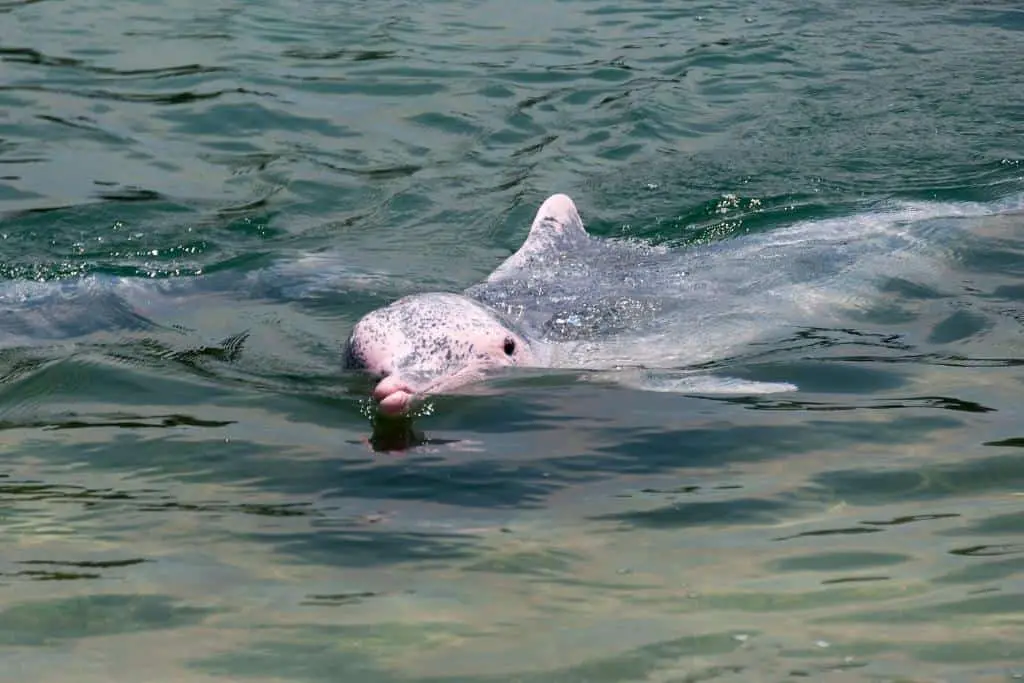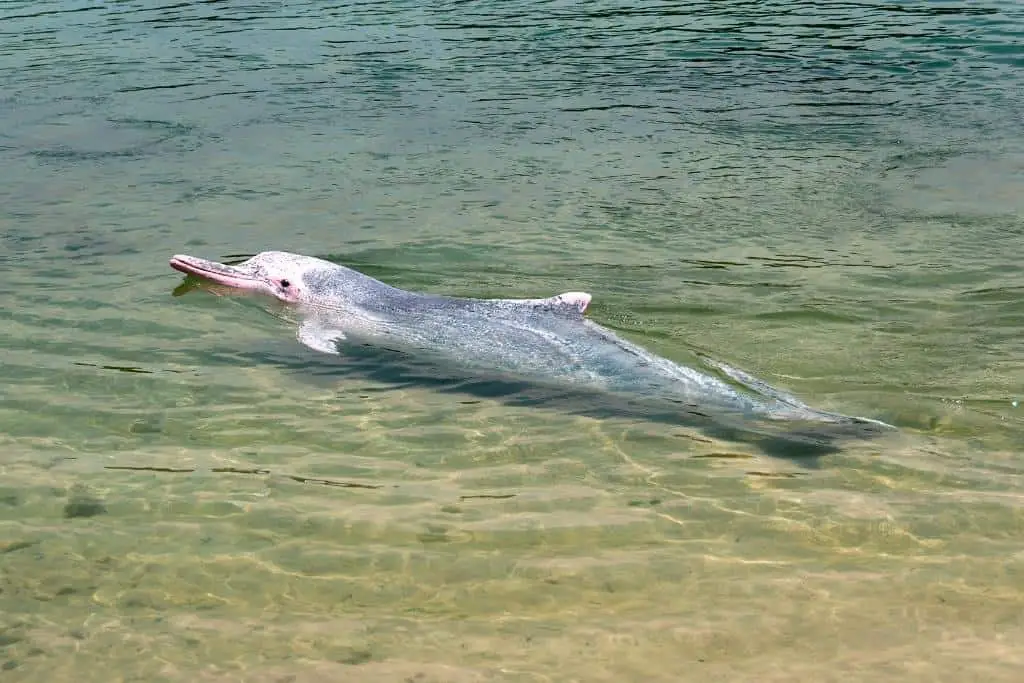Are Pink Dolphins Dangerous? The Truth About These Creatures
Pink dolphins are among the most beautiful and majestic creatures in the world. But are they dangerous?
Do they come from a particular place, and what are the risks of getting near them?
In this article, we will explore all you need to know about pink dolphins so that you can make an informed decision about whether or not to approach them.
Are pink dolphins dangerous to humans?

While pink dolphins are generally gentle creatures, they can sometimes be aggressive towards each other, particularly during mating season.
However, they’re not known to be dangerous to humans. In fact, pink dolphins are often quite curious about people and may even approach them in the water.
So while you might want to keep your distance from an aggressive dolphin during mating season, there’s no need to be afraid of them.
Outside of the mating season, males and females often form bonds with each other, but these bonds can be broken if a female becomes pregnant or if a male finds a more attractive mate.
While there have been no reports of Amazon River dolphins attacking people, they are still wild animals and should be treated cautiously.
If you’re planning on going on a dolphin-viewing excursion or exploring an area where these dolphins live, it’s best to be prepared. Make sure you know how to protect yourself from these animals, just in case.
And, as always, if you have any questions or concerns, be sure to speak with a qualified professional before setting out on your adventure.
Amazon River Dolphin Scientific Name an Info

- Also known as the pink river dolphin, it is one of the few freshwater dolphins worldwide. The scientific name for this dolphin is Inia geoffrensis.
- This dolphin has two subspecies: the Inia geoffrensis geoffrensis and the Inia geoffrensis boliviensis.
- The Amazon River Dolphin, also known as the Boto, is the larger member of the river dolphin family, with males reaching up to 8.4 feet in length and females reaching up to 7.1 feet in length.
- This dolphin has a pink or gray body with no dorsal fin. It has a long beak-like snout filled with 23-35 teeth.
The diet of the Amazon River Dolphin consists of fish, crustaceans, and mollusks. These dolphins are social animals that live in groups of 2 – 4 individuals.
These dolphins are shy and elusive creatures that humans do not see often. However, they are an essential part of the Amazonian ecosystem and play a vital role in controlling the fish population in the river basin.
The Amazon River Dolphin is a vulnerable species on the IUCN Red List due to threats from habitat loss, pollution, entanglement in fishing gear, and hunting. Although they are protected by law, their numbers continue to decline due to these threats.
Efforts are being made to preserve their habitat and reduce the threats they face, but more needs to be done to ensure the future of this fantastic species.
Amazon River Dolphin Behavior
The pink river dolphin’s most distinctive characteristic is its grin, which is discernible even when submerged.
They also have rounded foreheads and long, slender beaks. Another interesting fact about pink river dolphins is that females are smaller than males, unlike other river dolphin species.
Amazon river dolphins are shy and reclusive creatures that spend most of their time in small groups. They’re gentle and non-aggressive but also very curious and have been known to approach boats and humans out of curiosity.
Amazon River Dolphin Physical Characteristics

The Amazon River Dolphin is a unique and fascinating creature. They are one of the few river dolphins that are still in existence, and they are also one of the largest.
They can weigh up to 200kg (440lbs), and their skin is a smooth grey or pink color. They are also speedy, with a top speed of 18mph.
However, despite their impressive physical abilities, they have a relatively short lifespan of only 12-16 years.
Where Pink Dolphins are Found
You might be surprised to learn about several different pink dolphin species. The best known is the Amazon River dolphin, which is found in the freshwater channels of the Amazon River and connects the Orinoco River in South America.
However, pink dolphins live in China, India, and Nigeria river systems.
So, where exactly do these beautiful creatures live?
The Amazon River dolphin has the most extensive range of any of the pink dolphins, spanning much of their available freshwater habitat space. They can be found in Brazil, Colombia, Ecuador, Peru, and Venezuela.
Meanwhile, the Chinese river dolphin can be found in the Yangtze River in China.
And finally, the Indian river dolphin can be found in the Ganges-Brahmaputra-Meghna river system in India and Bangladesh.
How rare are Pink Dolphins?
Well, it depends where you’re looking. They’re actually quite common in some regions of the world, like the Amazon River. But sightings can be rare if you’re not in one of their hotspots.
So if you’re visiting pink dolphin hotspots, sightings aren’t all that rare. In certain places, Amazon River dolphins are relatively abundant. They are an endangered species due to pollution and habitat loss, so it’s essential to be mindful of that when you are lucky enough to spot one in the wild.
However, they’re under threat from habitat loss and hunting. River dolphins are rapidly disappearing, and so are their natural river habitats. In the Brazilian and Colombian Amazon, river dolphins are often deliberately killed for use as bait.
As a result, pink river dolphins are becoming increasingly rare. If we want to keep these fascinating creatures around for future generations, we need to do more to protect their habitats.
Why Are Amazon River Dolphins Pink?
Unlike other dolphins, which have thick layers of blubber, the pink river dolphin has fragile skin. As a result, its blood vessels are much more visible than other dolphins. And since the blood of these animals is oxygen-rich (due to their frequent diving), it gives them their characteristic pink hue.
These unique creatures are born grey, but the color changes from grey to pink as they grow older. Their skin becomes more transparent with time, revealing the blood vessels.
Males, on the other hand, are generally brighter than females owing to greater intra-species violence.
Adults generally have solid or mottled pink; some individuals have a deeper dorsal surface. The temperature, water transparency, and geographical location determine the color difference.
Are Pink Dolphins Real?
While their striking coloration makes them seem like something out of a fairy tale, the truth is that pink dolphins are authentic and very fascinating.
These dolphins are considered albino, meaning they lack the pigment that gives other dolphins their characteristic gray coloration. In addition to their unique coloring, pink dolphins are notable for their friendly nature and intelligence.
They are often seen accompanying boats and swimming alongside humans, and they have been known to help lost swimmers find their way back to shore.
Albino dolphins, in general, are incredibly rare, and only a handful exist in the world. One of the most famous albino dolphins is named Pinky, found in Calcasieu Lake, Louisiana.
While pink dolphins are certainly a sight to behold, they are also very delicate creatures. Because they lack the melanin that protects against the sun’s harmful UV rays, pink dolphins are at risk of sunburn.
Pink dolphins are unique animals, and their striking appearance will leave a lasting impression on anyone who sees them.






